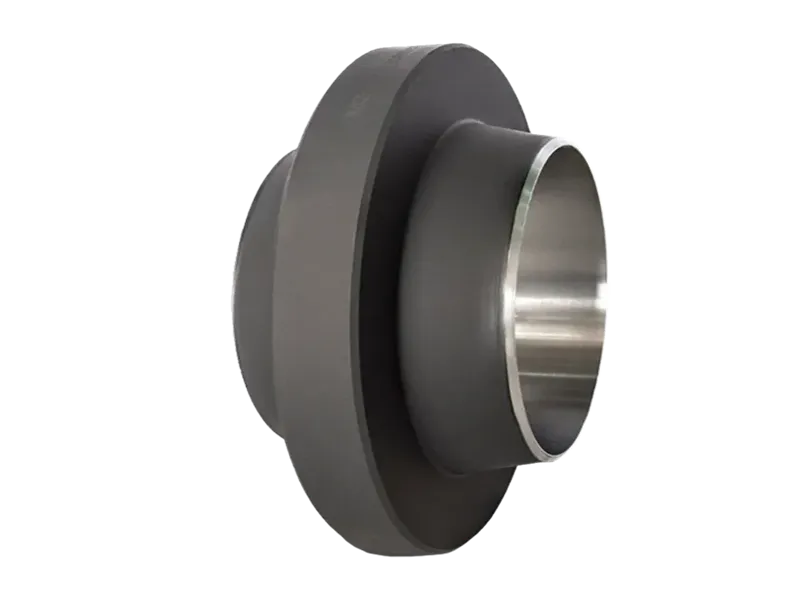Carbon steel flanges are essential components in the UK, with flange bodies typically made of robust carbon steel. Manufacturing involves casting, medium plate rolling, forging, and cutting, all executed with precision and care. The craftsmanship ensures varying quality levels, catering to diverse industry needs.
Dimensions Of Carbon Steel Flanges UK
Carbon steel flanges are expertly crafted in China to meet strict national standards for dimensions and tolerances. It is important to be wary of inferior flanges made with outdated steel or welding defects like cracks and pores. Non-standard carbon steel flanges that result in water leakage are considered second-standard flanges within the industry.

The pressure markings for carbon steel flanges are categorized as PN marks and Class marks. PN markings include “PN2.5; PN6; PN10; PN16; PN25; PN40; PN63; PN100; PN160; PN250; PN320; PN400,” providing 12 pressure levels. In contrast, Class markings consist of six pressure levels, such as “Class150; Class300; Class600; Class900; Class1500; Class2500.”
Carbon steel flanges are invaluable due to their exceptional ability to connect and seal pipes effectively. The use of carbon steel forged flanges ensures flawless pipeline connections and facilitates easier pipeline replacement and disassembly during maintenance.
Carbon steel flanges profoundly impact the machinery industry and play a vital role in economic development. It is crucial to follow the advancements in carbon steel flanges closely, align with modern industry trends, and integrate with the global carbon steel flange forging industry.
The Forging Process Of Carbon Steel Flanges UK
The forging process for carbon steel flanges utilizes assorted methods based on the movement of the forging die. These methods, including oscillating rolling, oscillating forging, roll forging, cross wedge rolling, ring rolling, and cross rolling, offer distinct advantages.
Precision forging can be achieved with oscillating rolling, oscillating forging, and ring rolling, while roll forging and cross-rolling are ideal for processing slender materials to optimize material usage. It is imperative to leverage computer-controlled forging die movement and rotary forging processes to attain forgings with complex shapes and high precision while exerting lower forging force. This technological approach ensures top-quality products and efficient use of resources.
The Production Of Carbon Steel Flanges UK
When the carbon steel flange production blank is cold forged, it will deform and work to harden, which will cause the forging die to bear a high load.
Therefore, it is necessary to use a high-strength forging die during forging and treats with a hard lubricating film to prevent wear and adhesion. In addition, to avoid cracks in the carbon steel flange blank, an intermediate annealing process is also required to improve the deformation resistance of the carbon steel flange.
Carbon steel flanges are set on the pipe end using flanges, steel rings, etc., and they can move freely on the pipe end.
The Working Principle Of Carbon Steel Flanges UK
There is a specific working principle for forging carbon steel flanges. According to the production process, production technology, and the use of carbon steel flanges, there is a certain working principle. The working principle is to utilize the insulation properties of carbon steel flange gaskets.

High-strength carbon steel flange insulation, carbon steel flange on both sides of the electrically insulating flange factory. Mary iron is commonly used with galvanized pipes (energy-saving iron) and is stronger than steel and more substantial than iron.
Low carbon steel and low carbon steel the carbon content of low carbon steel makes it easy to accept various processing such as forged carbon steel flange processing, welding, and cutting, commonly used in the manufacturing of chains, rivets, bolts, and shafts.
Standards And Requirements
- When planning carbon steel forged flanges, pay attention to 5 points. Tool design: carbon steel forged flanges comprise 2 900 clamping base plates, two flange plates, two vertical plates, and 4 stiffening plates. To ensure the rigidity of the tool, the welding joint of the connecting plate should be welded through the groove with a welding angle of 20-30mm.
- The corresponding bolt holes ensure the flange can be accurately connected to the bracket. There is a space between the back of the small end flange and the pallet, which can be placed in a small manual jack and follow the intention of the vertical plate, in the flange plate A notch is formed on the tool to fit the elbow into the tool. A tool with a thicker steel plate forming a rough groove structure will suffice. Rigidity requirements during cutting.
- The tooling requirements require that the two flange surfaces of the carbon steel forged flange be straight to each other, while the worktable of the vertical lathe is reversed, so the main function of the tooling is to operate the big head flange. Upper bolt holes connect the tool to the flange. When clamping the tool to the table, ensure that the plane of the flange to be machined is concentric and parallel to the vertical lathe table.
- In order to reduce the number of tools, the tool should be able to change the direction of the tool to ensure that both end flanges of the elbow can be machined on one tool. When used together, the mold must have satisfactory rigidity, otherwise it will seriously affect the processing quality of the flange sealing ring groove. Therefore, in a satisfactory environment, the height of the tool should be as low as possible to increase rigidity and ease of operation.
- The radius of the tool and carbon steel flange should not exceed the working radius of the vertical car and can be easily adjusted when clamping the tool. Mold stiffness verification, the slotted structure cantilever beam is stressed when the mold rotates, bends and changes, and the deflection and rotation angle should be verified. Through process inspection, the maximum deflection is 7.27×10-7m, the maximum angle is 8.969×10-5, the deformation is very small, and steel bars are added to the relevant parts.
Things To Note When Producing Carbon Steel Flanges
The carbon steel flange comprises two clamping base plates with an included angle of 90°, two flange supporting plates, two vertical plates, and four reinforced rib plates. To ensure the equipment’s rigidity, the welding seam of the connecting plate should be opened so that the groove is welded through and the welding fillet is 20-30mm high.

Corresponding bolt holes are drilled on the flange support plate, and a gap is created between the back of the small end flange and the support plate to accommodate a small manual jack. Cut out the notch so the elbow can be installed in the tool.
When clamping the tooling on the workbench, the flange plane to be processed should be concentric and parallel to the workbench of the vertical lathe. The tooling should be able to change the clamping position to ensure that both ends of the elbow can be processed on one tooling.
At the same time, the tooling needs to be rigid enough otherwise it will seriously affect the processing quality of the flange sealing ring groove.
Elite Piping Manufacture is committed to producing and selling carbon steel flanges. Our carbon steel flanges are available in various models and can undoubtedly meet your production needs. You are welcome to contact us at any time.
GET IN TOUCH
Company:
Elite Piping Manufacture Co., Ltd.
Factory Address:
Office # 805, Building No. 6 Poly Metropolitan, Yongshum Town, Tongzhou District, Beijing, China.
Contact Person:
Michael
Contact Numbers:
+86 186 1829 1381
Email:
elite@elitepiping.com

